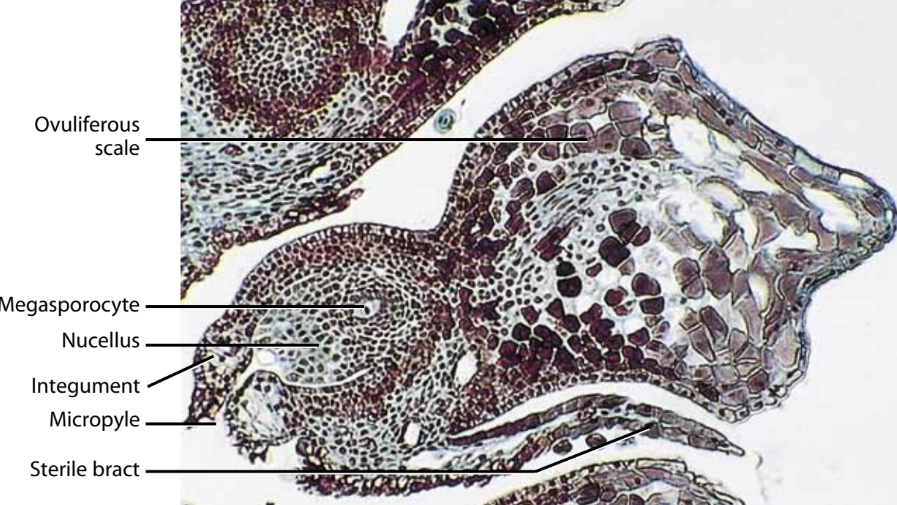Test III Study Guide (byrophytes, gymnosperms, seedless vascular)
1/48
There's no tags or description
Looks like no tags are added yet.
Name | Mastery | Learn | Test | Matching | Spaced |
|---|
No study sessions yet.
49 Terms
Byrophytes are a group of organisms that are transition between…?
Green algae and vascular plants
What are the characteristics that byrophytes derived from the green algae?
Lack Vascular tissue
Flagellated sperm
Nuclear envelope at mitosis and Phragmoplast during cytokinesis
Oogamous sexual reproduction
Haploid gametophyte stage is dominant
Contain clholoplast with well developed grana
What is the flagellated cell in bryophytes?
Sperm cell
After spore are dispersed and undergo mitosis they will develop into a male and female gamtophyte which are haploid and produce a archegoniophore and a antheriophore. The antherdiopore undergoes mitosis to create sperm that is transported which water to a archegonia
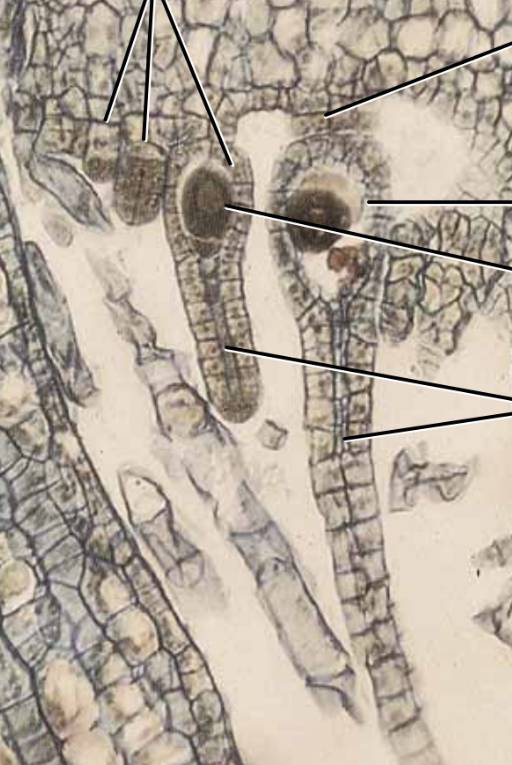
What are the parts of the bryophyte archegonia?
One single egg cells, with a swollen basal portion
Outside of the neck and vent form a sterile protective layer of cells,
Central cells of the neck are neck canal cells, that disintegrate when the egg is mature→ results in a fluid filled tube
After fertilization, as the embryo develops the venter undergoes cell division and this enlargement of venter is the Calyptra.
The characteristics of antheridia in byrophytes
Elongated antheridium on a stalk that consists of a sterile jacket layer, one cell thick that surrounds nervous spermatogennous cells/tissue→ develop into sperm cells.
Single biflaggulated sperm
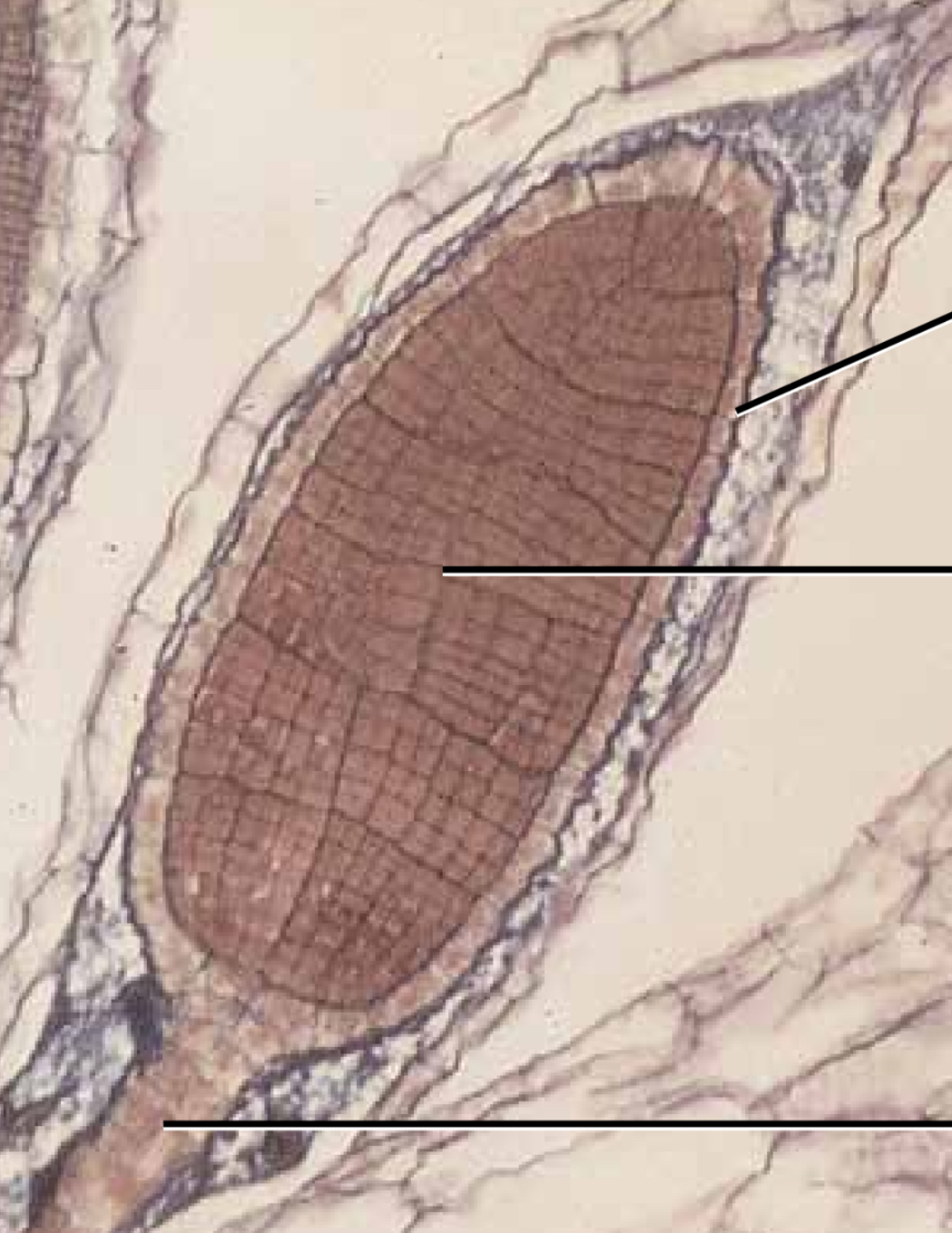
What is the term “Embryophytes” mean?
Multicellular, matrotrophic embrup is basic term- synonym for plants.
What is matrotrophy?
Zygote remains in the archegonium, where it is nourished by sugars, amino acids, provided by the maternal gamtophyte.
Food derived from mother
Has placenta, foot-embedded in archegonium and seta and a capsule
Where does fertilization occur in byrophytes?
Archegonium,chemicals are released to attract sperm
What is the major difference of spore walls and Charophytes?
Sporopollenin, zygotes are lined with this to survive the dispersal through the air from one moist site to another.
Remain viable for long periods and tolerate microbial attacks
What are the functions of the foot, seta and capsule?
Foot(2n): the sporophyte is permanently attached to the gametophyte, embedded in the archegonium/ transfer of material from the gamtophyte to sporophyte
Seta(2n): Acts as a supporting stalk that elevates the sporangium embed in the tissue from the gametophyte (hornworts lack this)
Capsule (2n): which is the sporangium that contains haploid spores, also aids in dispersal

What is produced in asexual reproduction in Marchancia?
Gemma Cups-located on the dorsal surface of the gametophyte. Cup like structures. Splashed by the rain and may grow into new gamtophytes IDENTICAL to the parent plant- derived by mitosis
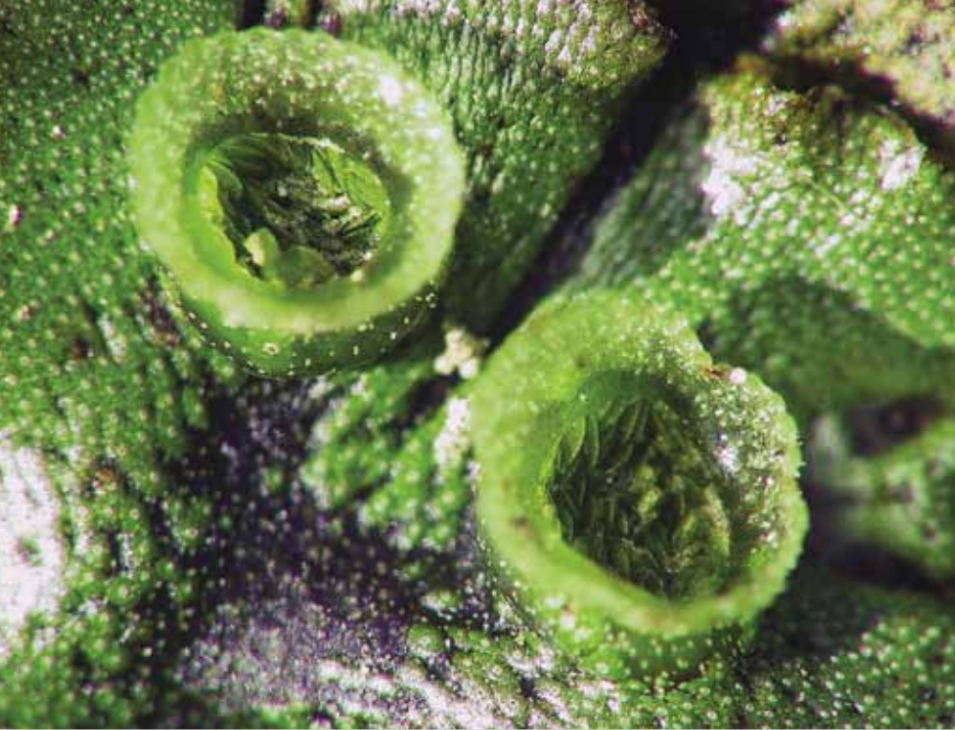
What are the Characteristics of Marchancia?
Dichonmouly branched, and the gametangia are borne on structures called gamtophores.
Unisexual, and the antheridia are borne on disk headed gamtophores- antheridiophores
Archegonionophores, borne on umbrella-headed gamtophores
Thallus, is a flattened that is not differentiated into root, stem or leaf, separated by upper and dorsal layers
Contains pores that are used for gas exchange
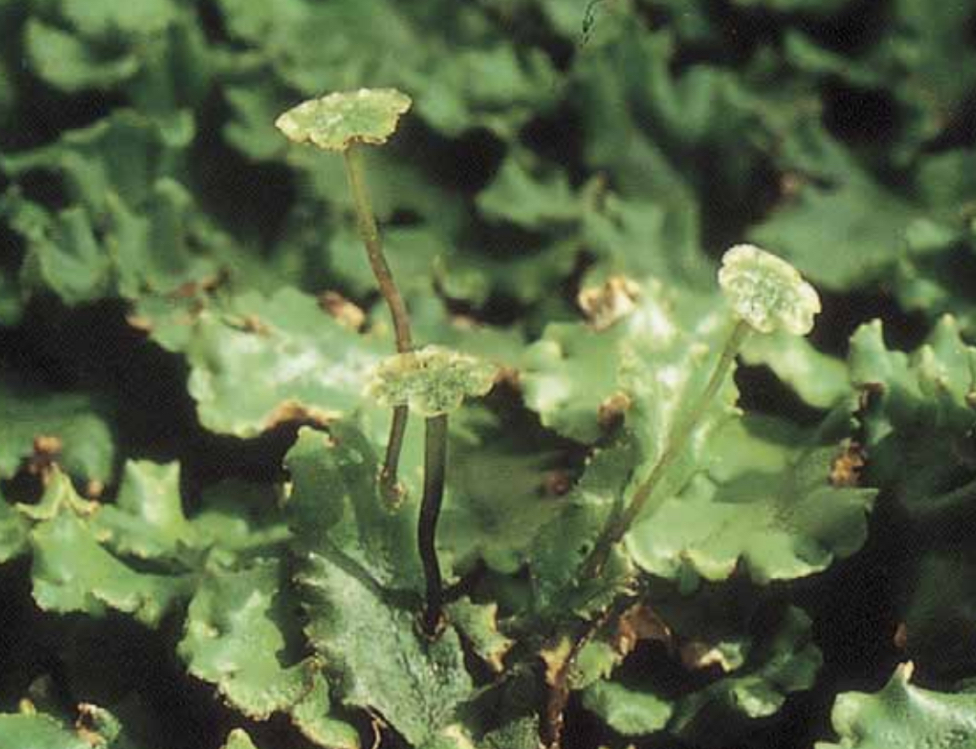
What does the mature sporangium contain in liverworts?
Spores and elators. Eaters are elongates cells that have moisture absorbing wall thickenings, that are sensitive to slight changes in humidity.
After the capsule dries out and opens- the elaters undergo a twisting action for spore dispersal
In the genus Sphangum, what are the capsules raised on and what its function?
Pseudopodium, stalk, that the capsules are raised onto
What are hydroids
Water conducting cells, that are elongated that the walls are thin and are highly permeable to water, resemble treachery elements in vascular plants.
What are Leptoids?
Food conducting cells, that surround a strand of hydroids, which the tissue is called leptom
What are the ploidy levels in the byrophytes structure: Foot, seta, embryo, protonema, and the capsule?
Foot: diploid
Seta:diploid
Embryo;Diploid
Protonema:haploid
Capsule: diploid
What are the differences between liverwort Marchancia and the Hornwort anthoceros?
Hornworts- gametophyte is thalloid, and most have a singe cholorplast per cell. Basal Meristem. Never contain oil bodies
Sporophyte:Consists of foot and long cyclindical sporangium, with a meristem between he foot. Contains a cuticle stomata
Liverwort- both thalloid and leafy genera gametophyte- most cells have numerous cholorplast and many produce gemmae, growth from apical meristem. Always contain oil bodies
Sporophyte: contains little more than sporangium, and of a foot with a short seta, Phenolic material in epidermal cell walls, lacks stomata
What are the characteristics of Peat mosses, class Sphagnidae?
Two genera, Sphagnum, and Ambuchanania.
The sporophytes are red to blackish brown capsules that are raised on a pseudopodium
Contains a protonema, that is one cell layer thick that grows by marginal meristem
The gamtophyte arises from bud like structure that grows from one of the marginal cells
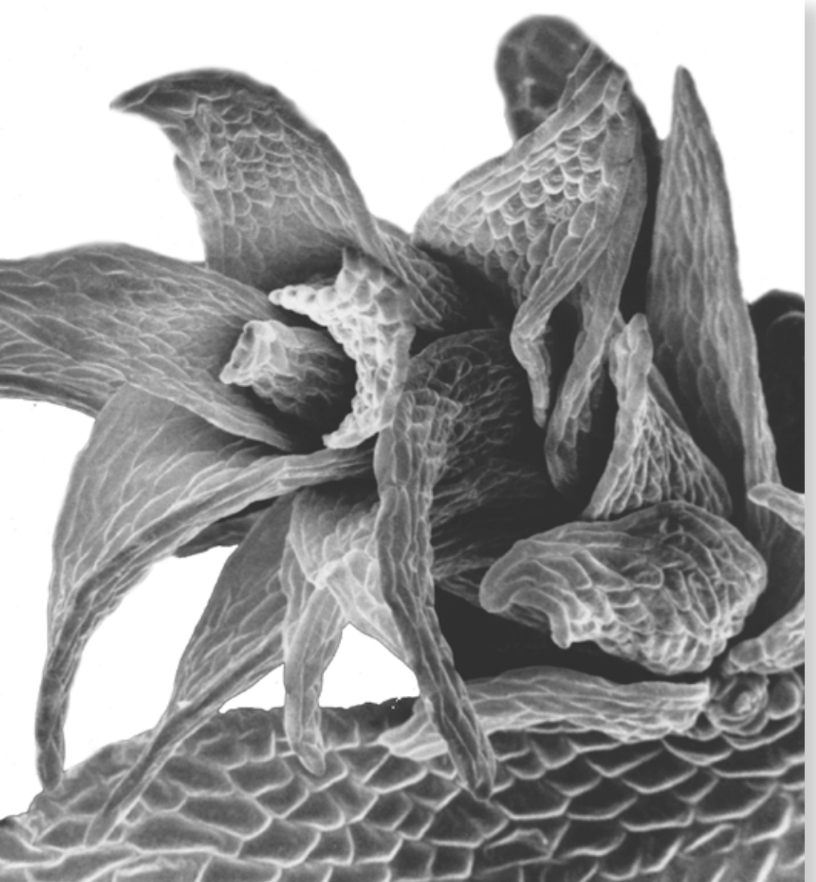
In evolution in Vascular plants what is the trend towards?
Increased protection of the gametophyte by the sporophyte. Sporophyte is free living and more complex.
Decreased reliance on water for the transferring from sperm to egg. Reduction in size in gametophyte.
What is the reproduction of vascular plants?
Alternation of heteromorphic generations, the dominant generation is the sporophyte.
What are the characteristics of the gamtophytes and sporophytes of Vascular plants?
Gamtophyte is structurally less complex than the sporophyte, also reduced in size, the nutritional dependency of the gametophyte on the sporophyte
All vascular plants are Oogamous, what does this mean?
Have a large nonmotile eggs and small sperm that swim to or conveyed to the egg. (Female and male gamete)
What is the order of the 4 major groups if vascular plants from the earliest to most recent.
Rhyniophytes, zosterophyllophytes, and trimerophytes (small stature and simple with a primitive morphology)
Monliophytes, lycophytes, ptogymnosperms, ferns , horsetails
Gymnosperms- seed plants- dominated land flora
Flowering plants-135 million years ago.
What are the three types of Stele?
Protostele
Siphonostele
Eustele
What is the Protostele? And an example?
Simplest and most primitive type of stele- consists of a solid cylinder of vascular tissue( phloem either surrounded the xylem or is interspersed within in. (NO PITH)
Saleginella, Psilotum

What is the siphnostele and an example?
Characterized by a central pith surrounded by a vascular tissue, the phloem may form only on the outside cylinder of the xylem or both sides of it.
Has leaf traces and leaf gaps
Example is fern
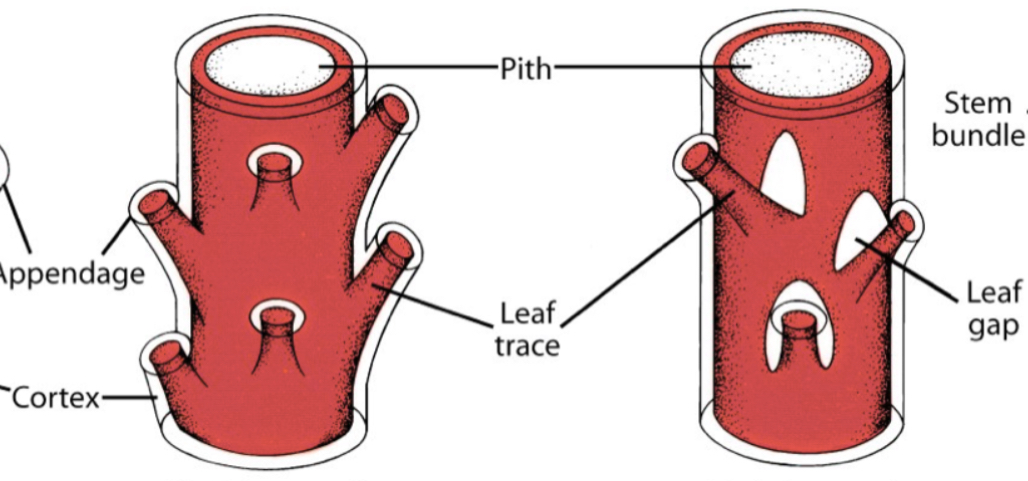
What is a Eustele and an example?
primary vascular cylinder, that consists of discrete strands around a pith, shown in almost all seed plants.
What are some Lycophyta characteristics
Club mosses:lycopodium, Selaginella, and isoetes (quillwarts)
Consists of nonwoody herbaceous plants
Posses microphylls ( leaves with single vein)
The sporophytes consists of a branching rhizome
Most with Protostele
The sporangia in on or in the axils of the sporophylls
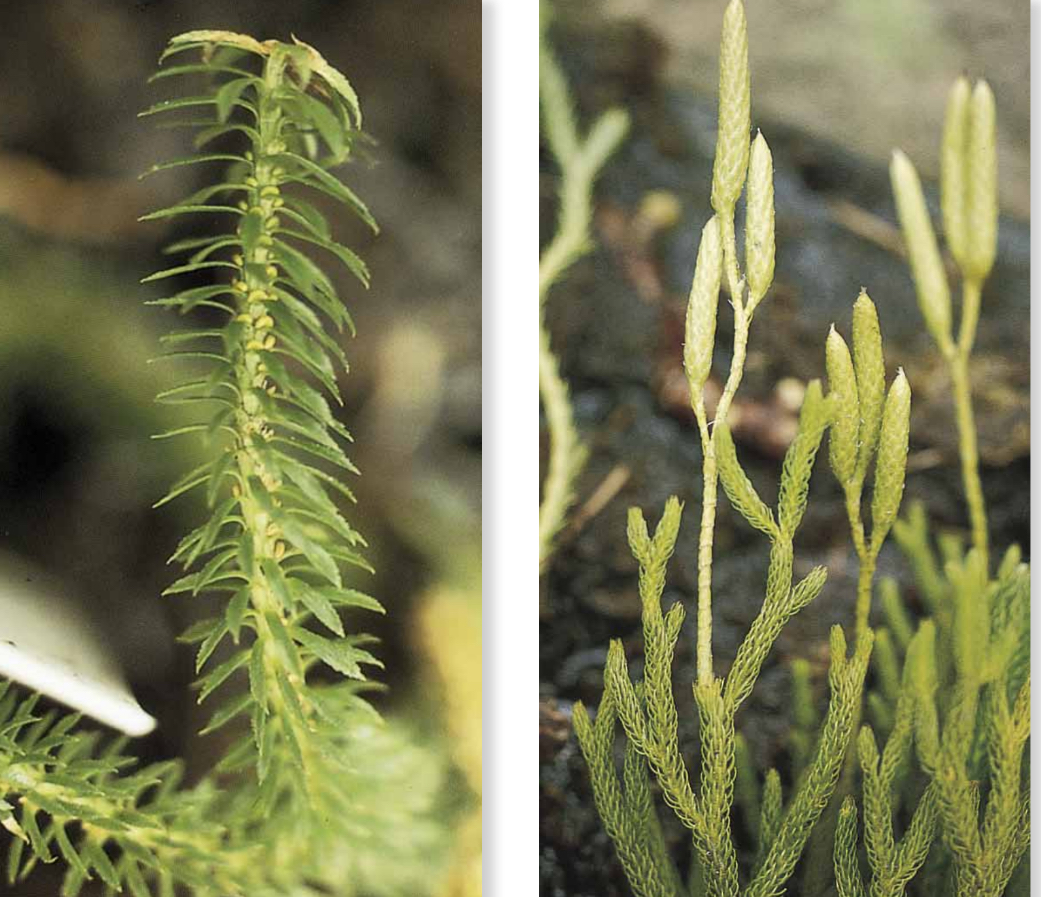
What are the Psilotophyta characteristics
Whisk fern: Psilotum, timesipteris
Lacks roots and leaves
Dichotomoussly branching
Rhizome with many rhizomes
Prostele
Homosporous and which sperms give rise to bisexual gamtophyte
The sporophyte becomes detached from the foot, which remains embedded in the gametophyte

What are the characteristics of ferns (pterophyta)→ larger phyla Monilophyta
Ophioglosses , and Botrycutum
Most are Homosporous Leptosporangiate ferns
However can have a Eusporangia(located at the surface of the tissue which the sporangia are produced) Innermost wall compromises the tapetum)or leptosporangia ( arise from a single superficial initial cell, combine to produce a large part of a sporangial stalk.
Bisexual gamtophyte- Archegonica and antheridia are borne on the lower surface of the Prothallus
Sporangia occur in cluster called sori
The sori are covered by specialized out growth called Indusia
What are the characteristics of Filicales?
Leptosporangia ferns
Have siphonostele
The sporangia occur on margins or the lower surfaces of the leaves, commonly occur in cluster called sori and these young sori are covered by a outgrowth called indusia- that shrivel when ready to shed the spores
The leaves are megaphylls
Leaves are divided into pinnae, which are attached to rachis
Young leaves are coiled, and this development is known as circinate venation- these are referred to fiddle heads
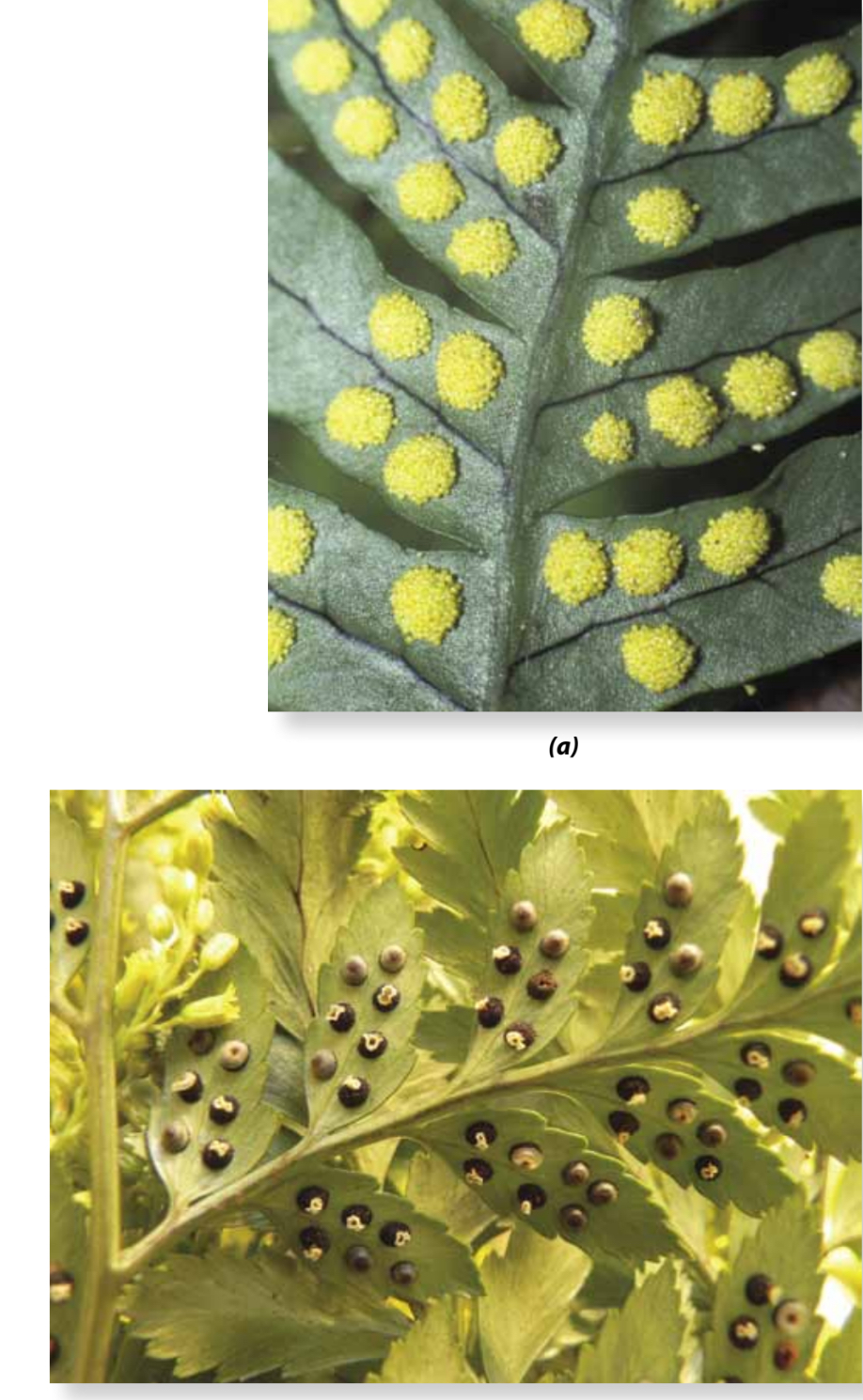
What are Equisetum (horsetails) characteristics
Jointed stems and rough textures
Scale like leaves are whorled at nodes
Rhizomes are perennial
Homosporous, and are borne along the margins of small umbrella like structures, that are clustered into strobilli ( cones)
Vegativative stems, and when the spores are mature they split along the inner surfaces. Elaters are formed
What are some isoetes characteristics
Quillworts- consist of a short fleshy underground site, bearing quill-like microphylls on its upper surface and each leaf has the potential to be a sporophyte containing Megasporanguim or microsporangium
Lack somata
Heterosporous
What are the heterosporous water ferns?
Salvininaceace and Marsileaceae
What is a seed?
Matured ovule containing an embyo
What is the Nucellus (megasporangium)and its ploidy levels?
A diploid tissue that surround the embryo sac. The function is to provide nourishment
What is megasporophyte (Megaspore mother cell) and its ploidy level
Diploid, undergo meiosis to create 4 haploid megaspores that only one of them survive
What is a megaspore and its ploidy level?
Haploid, This develops into the female gametophyte (megagametophyte) which is also haploid
What is a Embyo and its ploidy level in gynmosperms
Diploid, formed from the two zygotes, this is the young sporophyte that is protected by the megagametophyte, that has a diploid seed coat This makes the seed.
How are seeds dispersed in Gymnosperms?
Wind
What are the 5 phyla of seed plants?
Coniferphyta, Cycadophyta, Ginkophyta, Gnetophyta, and Anthophyta (Angiosperms)
What is the tallest lived tree?
the Redwood (Sequoia)
What are characteristics of the pine needs in Coniferphyta?
Spirally arranged, after a year or two of growth the pine produces its leaves in bundles, known as facicles that are wrapped by scale like leaves ( shoots)
Morphological determinate ( restricted in growth)
Thick cuticle, where there are one or more layers arranged, and the stomata are shrunken below teh surface
What is transfusion tissue?
The vascular bundles that are made up of xylem and phloem are surrounded by this
It’s compromised of living parenchyma cells and short no living trachids and it’s believed to conduct material between the mesophyll and vascular bundles
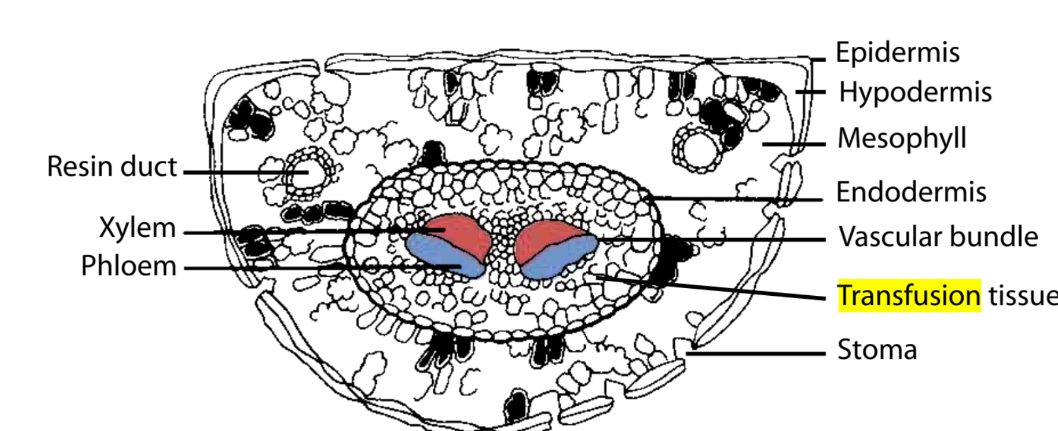
What is the longest-lived tree?
Bristlecone pine (Pinus Longaeva)
What is the Vascular Cambium of gymnosperms?
Evolutionary advancement, one that produces both secondary xylem (internally) (wood)and a secondary phloem (externally). (Blast)
What does the microsporangiate contain?
Pollen-producing cones are borne on upper branches.
Contains microspore mother cells that undergo meiosis to 4 haploid microspores, that consists of two prothallhial cells, a generative cell and a tube cell.
4 called pollen grain is the immature micro gamtophyte
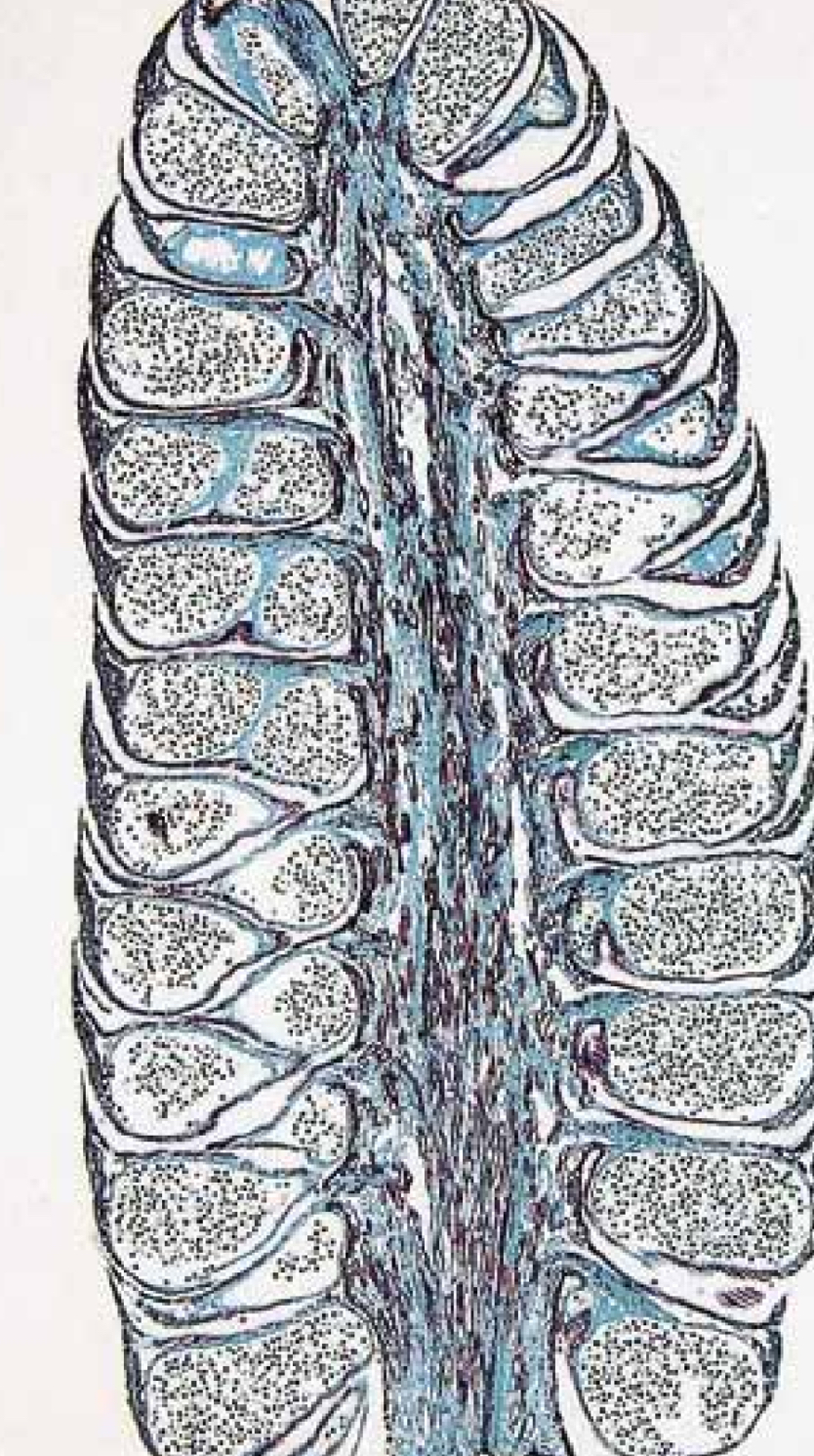
What is the seed scale complex?
Consists of the ovuliferous scales- which bears two ovules on its upper surface and a sterile bract
Scales are arranged spirally around the axis of the cone.
